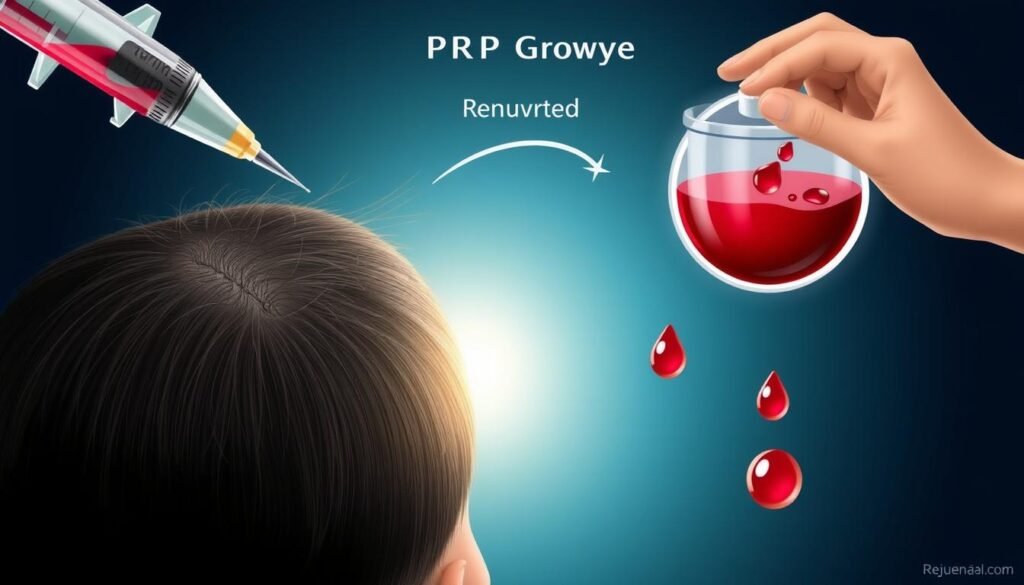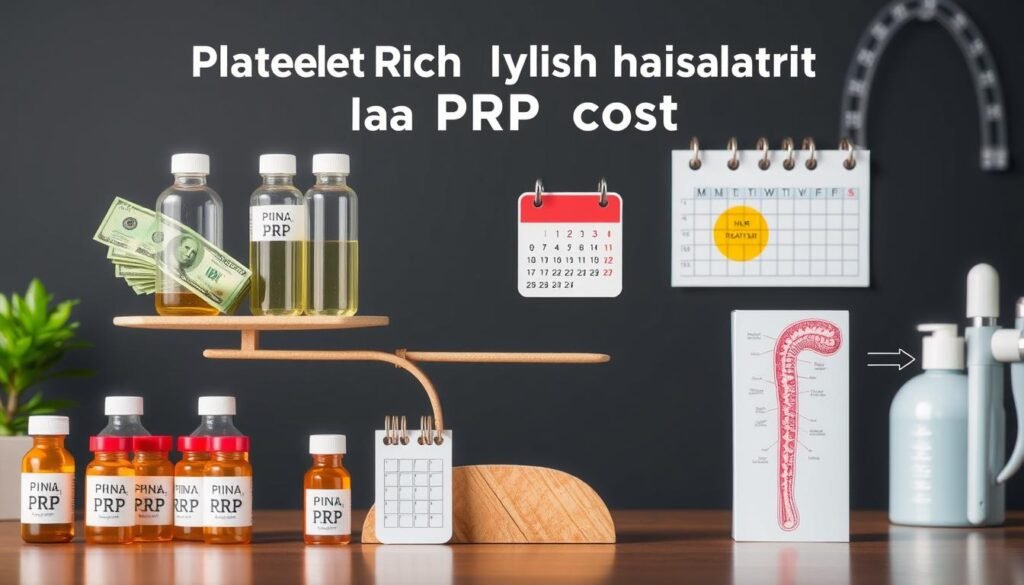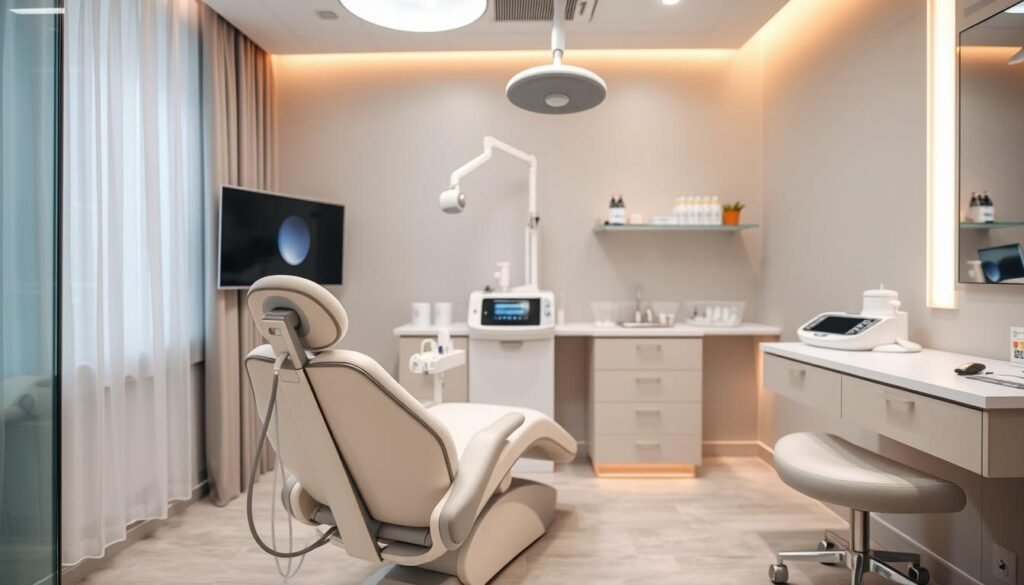Did you know that over 85% of men and nearly 50% of women face hair thinning or loss at some point? This fact highlights the urgent search for effective hair loss solutions. Platelet Rich Plasma (PRP) therapy is one such treatment gaining popularity for its promising results in hair growth and restoration. Yet, many potential patients are concerned about the cost of platelet rich plasma hair loss treatments. It’s important to talk about the money aspect of this advanced therapy.
In this article, you’ll find crucial details about the cost of platelet rich plasma therapy for hair. You will learn about PRP treatment costs and what factors affect the price. With this knowledge, you can make informed decisions about your hair restoration path.
Key Takeaways
- The average cost of PRP hair treatment ranges from $1,500 to $3,500 for initial sessions.
- Most patients require three to four sessions for optimum results.
- Geographic location and equipment quality can significantly affect PRP therapy pricing.
- PRP is generally a cosmetic procedure, which often means it is not covered by insurance.
- PRP is typically less expensive than hair transplants but costlier than topical treatments.
Understanding Platelet Rich Plasma (PRP) Therapy for Hair Loss
Platelet rich plasma therapy for hair loss is now quite popular. This method uses the body’s healing powers to boost hair growth. It does this by taking platelet-rich plasma from a patient’s blood. Then, it applies these growth factors straight to the scalp.
This targets the hair follicles specifically. The benefits of PRP for hair loss are many. Patients see better hair density and thickness. This is true for conditions like androgenetic alopecia and alopecia areata.
Research shows that PRP can really help restore hair. Many patients notice their hair looks healthier and fuller. PRP therapy also means little to no downtime. This makes it a good choice for those who want a non-surgical way to treat hair loss. Treatment often starts with one injection a month for three months. Then, it moves to maintenance sessions every six months.
Talking to healthcare experts is key. They can help you know more about natural remedies for hair loss. This lets you choose the best treatment plan. While PRP works well for many, results can differ. Factors like blood platelet levels and following the treatment plan affect success. Knowing the benefits of PRP for hair loss helps patients make smarter choices about their treatment.
How PRP Therapy Works for Hair Restoration
PRP therapy for hair loss uses the healing power of your own blood’s platelets. First, a little blood is taken from you. This blood goes through a centrifuge to focus the platelets. The platelet-rich plasma (PRP) is then injected into your scalp.

The treatment wakes up sleeping hair follicles, making them grow new hair. Studies show patients notice thicker hair and less shedding. With more treatments, these effects get even better, fighting hair loss effectively.
Each session takes 15-25 minutes, starting with drawing blood and then doing the injections. Patients often get several treatments, about a month apart. For upkeep, you might need a few sessions a year. If you want to learn more, check out this detailed guide.
PRP isn’t a complete cure for hair loss conditions like androgenic alopecia. But it does slow down hair loss and helps grow new hair. Patients like that it has little downtime and uses a natural method in the fight against hair loss.
Factors Influencing Platelet Rich Plasma Hair Loss Cost
The cost of PRP therapy varies a lot. It depends on where the clinic is. Places with higher living costs, like cities, might charge more. Treatment costs in New York or San Francisco can range from $1,500 to $3,500 per session.
Equipment quality also affects the price. Better technology usually means higher costs but better results. The experience of the doctor plays a role too. More experienced doctors charge more because they offer quality services.
The amount of hair loss you have can change the cost as well. More severe hair loss may need more treatments, which costs more. Typically, people get three to four sessions at first. Then, they might need more treatments every six to twelve months.
Buying treatment packages can save money, up to 20% less than single sessions. If you add extra products or techniques, it can also raise the price.
The following table shows what affects PRP therapy cost:
| Factor | Impact on Cost |
|---|---|
| Location | Higher in urban areas; lower in rural settings |
| Practitioner Experience | Higher fees for expert practitioners |
| Treatment Sessions Required | More sessions lead to increased costs |
| Equipment Quality | Advanced technology often results in higher prices |
| Maintenance Treatments | Added costs for ongoing care |
| Package Deals | Potential savings of up to 20% |
Knowing these factors helps you make a wise choice. It lets you plan your budget and find the best hair loss treatment.

Average Cost of PRP Hair Loss Treatment
Knowing what PRP hair loss treatments cost is key for those thinking about it. The price can change a lot. This depends on things like where you are, the expert you see, and your treatment plan. Most people will pay between $1,500 and $3,500 for the first set of treatments. This includes three to four sessions.
Cost Range for Initial Treatment Sessions
The cost for the first PRP session can differ. On average, it costs about $750. You’ll likely need more than one session. Most people get four to six treatments, four to six weeks apart. This helps get better hair growth, and around 64% of people see great results.
Additional Expenses for Booster Treatments
After your first treatments, you’ll need ongoing care to keep your hair growth. Booster treatments come with extra costs. They can be $400 to $1,500 each, based on what the practitioner charges and your needs. Getting treatments every four to six months is a good investment for lasting hair growth.
| Type of Treatment | Cost Range |
|---|---|
| Initial PRP Treatment Session | $750 |
| Initial PRP Treatment (3-4 sessions) | $1,500 – $3,500 |
| Booster Treatments | $400 – $1,500 each |
| Regular Maintenance (every 4-6 months) | Varies by provider |

Comparing PRP Hair Loss Treatment Cost with Other Options
When looking into hair restoration, it’s important to compare PRP and hair transplant costs. Both have different pricing, so it’s key to think about money and what you’ll get out of it.
Cost Analysis: PRP vs Hair Transplant
Hair transplant surgery is often seen as the top choice for restoring hair, but it’s more expensive at first. On the other hand, PRP therapy is cheaper for each visit. But, you might need to go more often. Despite this, PRP might show results quicker, but transplants can last longer, making them a good investment over time.
Topical Treatments vs PRP Costs
The prices of topical treatments and PRP for hair loss are quite different. Products like Minoxidil are cheaper, but they might not work well for everyone in the long run. Mixing PRP with these treatments can improve hair health over time. This mix could make PRP’s higher cost worth it. While topical options save money initially, PRP could offer better, lasting benefits.
Insurance Coverage and Payment Options for PRP Therapy
Many insurance companies view PRP therapy for hair loss as a cosmetic procedure. This often results in no coverage. Yet, some providers may cover it if it’s linked to a medical condition or treatment side effects. It’s key to know your insurance policy well. Words like ‘cosmetic’, ‘medical necessity’, and ‘experimental treatments’ really affect your chances of getting PRP coverage.
Insurance might cover PRP depending on the hair loss severity and its effect on your life. It’s also about whether you’ve tried other treatments before. If PRP is necessary for medical reasons, getting a doctor’s help to document this is crucial. Gather all your medical records and history of treatments to back up your claim.
If your insurance first says no, you might need to fight their decision. You can either ask for pre-approval or appeal against the denial. Paying for PRP has many options like:
- Health Insurance
- Health Savings Accounts (HSAs) and Flexible Spending Accounts (FSAs)
- Payment Plans
- Medical Credit Cards
- Financing Companies
- Personal Loans
It’s smart to talk to your insurance company about what they cover for PRP treatments. Also, discuss costs and payment options with your healthcare provider. Being proactive about finances can make managing the costs of PRP therapy smoother.
| Insurance Type | Coverage Status |
|---|---|
| Commercial Insurance | May cover if deemed medically necessary |
| Medicare | Generally not covered; classified as experimental |
| Medicaid | Limited coverage; varies by state |
Assessing Your Candidacy for PRP Hair Restoration
Figuring out if PRP hair restoration is right for you means looking at certain factors. PRP therapy uses your body’s own healing abilities to encourage hair to grow. However, it’s not equally effective for everyone.
People just starting to lose their hair are often the best candidates for PRP therapy. If your hair is thinning or your hairline is receding, you might see good results. Starting treatment early can make a big difference in how well it works.
Before starting, it’s vital to check for health issues that could make PRP less effective. Those with low platelet counts, some metabolic or autoimmune diseases aren’t good fits. Also, heavy smokers or those with current infections should look elsewhere. It’s all about knowing if your health allows for candidacy for PRP therapy.
Knowing the risks of PRP is also part of seeing if it’s right for you. You might have slight soreness or swelling, but these usually go away fast. Compared to surgeries like hair transplants, PRP is much safer.
If you want to learn more, check out this link for detailed info on PRP’s benefits.
| Criteria | Suitable Candidates | Unsuitable Candidates |
|---|---|---|
| Stage of Hair Loss | Early stages, thinning | Severe balding or extensive hair loss |
| Health Conditions | Generally healthy | Low platelet count, metabolic disorders, infections |
| Smoking Status | Non-smokers | Heavy smokers |
| Medications | None affecting blood clotting | Blood thinners or anticoagulants |
Success Rates and Expected Results of PRP for Hair Growth
Studies show PRP therapy is often successful, especially for male and female pattern baldness. A detailed study in 2022 found that 84% of people had positive results from PRP. Other research supports this, showing a consistent success rate.
After a year, most of the 20 people treated with PRP didn’t lose more hair. Their quality of life improved, according to the HAIRDEX 48 scale. This shows PRP’s long-lasting benefits.
PRP also helps people getting hair transplants. It speeds up recovery and increases hair thickness. In one study, 65% of patients had over 10 mm of new hair growth, way more than those who didn’t get PRP.
PRP is not just for common baldness. It’s effective against androgenic alopecia too. A 2014 study confirmed this. Many hope for better hair growth and density thanks to PRP.
Many see positive changes with PRP, which keeps interest high. But, it’s important to stay realistic and patient. For more on PRP success rates, click here.
| Study | Positive Results | Participants | New Hair Growth |
|---|---|---|---|
| 2022 Study | 84% | Varied | N/A |
| FUE Hair Transplant Study | N/A | 40 | 65% |
| Longitudinal Observation | N/A | 20 | 20% |
Conclusion
Understanding the PRP therapy cost summary is key for anyone thinking about this hair treatment. The cost of PRP therapy can range broadly, from Rs. 2,000 to Rs. 20,000. This varies based on the clinic’s facilities and the doctor’s expertise. Compared to hair transplant surgery, PRP therapy is safer, less invasive, and often cheaper.
The benefits of PRP treatment are numerous. These include few side effects, a fast treatment time, and no risk of disease since it uses your own blood. Most people see better hair thickness and growth after about three months of regular sessions. It’s wise to talk to a specialist to see if it’s right for you and to discuss your options.
In the end, those considering PRP therapy should think about the costs and benefits. Consulting with experts to see if PRP therapy fits your hair restoration goals is a smart move. Making informed choices will lead to happy results in achieving healthier hair.
FAQ
What is the average cost of platelet rich plasma hair restoration?
FAQ
What is the average cost of platelet rich plasma hair restoration?
The initial cost for PRP hair therapy ranges from
FAQ
What is the average cost of platelet rich plasma hair restoration?
The initial cost for PRP hair therapy ranges from $1,500 to $3,500. This covers three to four sessions.
Are there ongoing costs associated with PRP therapy for hair loss?
Yes, patients might need more treatments to keep their results. This means extra costs later on.
How does the cost of PRP therapy compare to hair transplant surgery?
PRP therapy’s cost is less than surgery but more than topical treatments. It’s a middle-priced option.
Will my insurance cover the cost of platelet rich plasma therapy for hair loss?
Most insurance plans don’t cover PRP therapy. It’s seen as cosmetic, so you might have to pay out-of-pocket.
What factors influence the cost of PRP hair loss treatment?
The cost depends on where you are, the equipment’s quality, and the doctor’s experience.
Who is an ideal candidate for PRP therapy?
People with certain hair loss types and stages are best for PRP. Always check with a pro if it’s right for you.
What kind of results can be expected from PRP treatment?
Results vary, but many see better hair thickness and density. This is backed by studies.
What is included in the cost of platelet rich plasma hair regrowth treatment?
Costs cover drawing blood, processing it for platelets, and scalp injections.
Are there payment plans available for PRP hair treatment?
Some clinics have payment plans or financing to help cover PRP therapy costs.
,500 to ,500. This covers three to four sessions.
Are there ongoing costs associated with PRP therapy for hair loss?
Yes, patients might need more treatments to keep their results. This means extra costs later on.
How does the cost of PRP therapy compare to hair transplant surgery?
PRP therapy’s cost is less than surgery but more than topical treatments. It’s a middle-priced option.
Will my insurance cover the cost of platelet rich plasma therapy for hair loss?
Most insurance plans don’t cover PRP therapy. It’s seen as cosmetic, so you might have to pay out-of-pocket.
What factors influence the cost of PRP hair loss treatment?
The cost depends on where you are, the equipment’s quality, and the doctor’s experience.
Who is an ideal candidate for PRP therapy?
People with certain hair loss types and stages are best for PRP. Always check with a pro if it’s right for you.
What kind of results can be expected from PRP treatment?
Results vary, but many see better hair thickness and density. This is backed by studies.
What is included in the cost of platelet rich plasma hair regrowth treatment?
Costs cover drawing blood, processing it for platelets, and scalp injections.
Are there payment plans available for PRP hair treatment?
Some clinics have payment plans or financing to help cover PRP therapy costs.